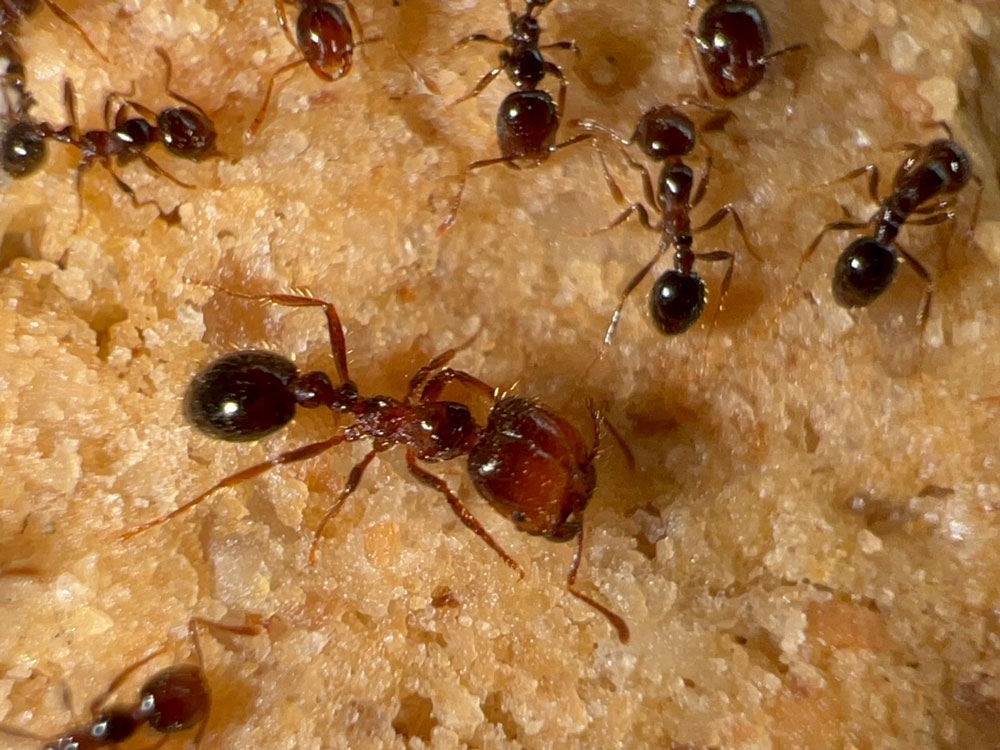
Tropical Fire Ant
Plagiolepis alluaudi)
Species Info General
Other common names include: Big-headed Native Fire Ant
This is the aggressive and common fire ant that has been bothering Hawaii residents since at least as far back as the 1860s. Wheeler (1910) wrote “Solenopsis geminata, the “fire-ant,” is armed, as its popular name indicates, with a formidable sting which it uses on the slightest provocation.” Forel (1893) wrote “These ants are very pugnacious, especially when their central nest is disturbed. The sting is unpleasant, but not very painful.” However, many would beg to differ: the sting of this ant is both unpleasant and pretty painful. Indeed, Creighton (1950) referred to this ant’s sting as “particularly painful”. Forel (1893) went on to say “They seem to live principally, if not entirely, on vegetable matter; they are especially fond of sweet substances. I have found considerable quantities of grass-seeds stored in small chambers in their nests.” In Hawaii, Tropical Fire Ants thrive best in dryer, leeward areas where it has less competition with the moisture-preferring African Big-headed Ants with which it does not get along. As a result, encounters with this fire ant are frequently reported from beach parks, sand dunes, road shoulders, and other sunny, open areas like lawns, soccer fields and the like. This preference for dry, sunny locations is in stark contrast to the Little Fire Ant which thrives best in the wet, hot and humid forested areas of the north shore.
Deyrup (2017) preferred the common name “Big-headed Native Fire Ant” in his book on the ants of Florida, perhaps because this ant is native to temperate areas in addition to tropical zones, and/or perhaps to distinguish this species from the Red Imported Fire Ant which invaded the American South starting in the 1930s. As for the Tropical Fire Ant’s native range, Trager (1991) wrote, “S. geminata is apparently native from the southeast coastal plain and Florida to Texas . . . south through Central America to northern South America”



Identification/Description
Tropical Fire Ants are variable in both size and color, but tend to be a light red to dark brick-red color and noticeably larger than the ants you tend to find on the kitchen counter. This species is noted for having occasional individuals with disproportionately large heads. Most of the ants in the colony, however, have heads that are quite normal looking. Forel (1893) wrote “In their movements the small-headed workers are moderately active; the large-headed ones move slowly, and in a staggering way.”


Impacts
- Serious nuisance species with painful stings that occasionally lead to dangerous allergic reactions
- At times, a nuisance to agriculture via its appetite for fresh seeds: they will sometimes collect seeds from your garden soon after you plant them, while later they chew on the freshly sprouted seedlings of the seeds that they previously missed.
- Like many ants, it will tend to aphids, scale, mealybugs and similar agricultural pest insects: “It is one of the species that are very fond of attending scale insects and, by protecting these, must cause, indirectly, considerable damage.” (Mann 1920)
- At other times, however, this ant “might safely be placed in the list of beneficial insects. W. E. Hinds, of the Department of Agriculture, reports that it is an established enemy of both the otton leaf worm and Cotton boll weevil, while I have personally seen these ants capture and carry off several leaf roller larvae.” (Lewis 1912). Others have observed this ant attacking melon flies & corn leafhoppers (Fullaway & Osborn (1917).
History
- This species was on the first annotated list of ants in Hawaii, published in 1879, and for nearly a century was confined almost exclusively to Oahu. In 1945 Fullaway & Krause wrote “Apart from the Mahukona district in the northwest section of the island of Hawaii, where it was observed on one occasion, this ant is found only on Oahu”. These fire ants made it to Molokai in the 1950s, Maui in the 1960s, Lanai in the 1980s, Kauai in the 1990s and were first detected on Kahoolawe in 2003.
Resources/References
- Maui Invasive Species Committee’s Brief Guide to Maui’s Ants – Solenopsis geminata
- Solenopsis geminata – AntWiki
- Creighton 1950
- Deyrup, M. 2017. Ants of Florida – Identification and Natural History. CRC Press, Boca Raton, Florida. 423 pp.
- Forel 1893
- Fullaway, D. T. & Krause, N. H. L. 1945. Common Insects of Hawaii. Tongg Publishing Co., Honolulu. 228 pp.
- Fullaway, D. T. & Osborn, H. T. 1917. [Notes & Exhibitions]. Solenopsis geminata. Proceedings of the Hawaiian Entomological Society 3(4): 284.
- Lewis, L. V. 1912. [Notes & Exhibitions]. A Few Notes on Solenopsis geminata. Proceedings of the Hawaiian Entomological Society 2(4): 175–178.
- Mann 1920
- Trager (1991)
